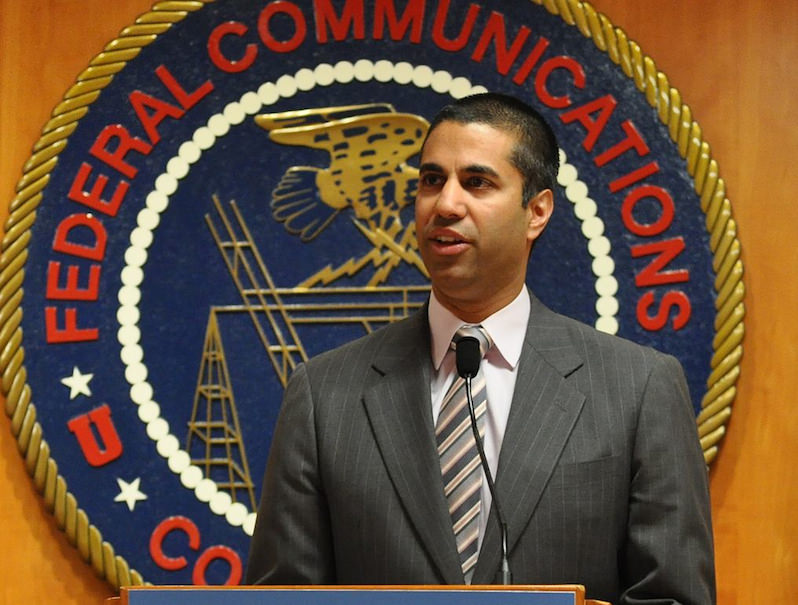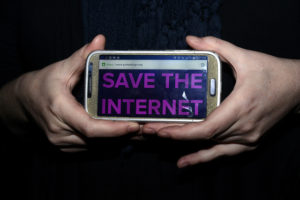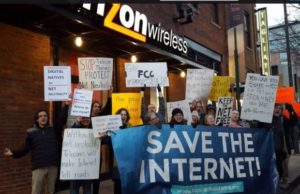Six Things Trump’s FCC Chairman Doesn’t Want You to Know About Net Neutrality
As the agency moves forward with its misinformation campaign to reverse open internet protections, these key points are worth highlighting. Ajit Pai, now chairman of the Federal Communications Commission, speaking in 2014. (Wikimedia Commons)
Ajit Pai, now chairman of the Federal Communications Commission, speaking in 2014. (Wikimedia Commons)
By Timothy Karr / Moyers & Company
Ajit Pai, now chairman of the Federal Communications Commission, speaking in 2014. (Wikimedia Commons)
Under its Trump-annointed chairman, Ajit Pai, the Federal Communications Commission decided last Thursday to revisit its net neutrality ruling. The agency has reopened a docket for public comments on Pai’s proposal to undermine the safeguards needed to protect people from having their internet service providers block, throttle or de-prioritize the online content they want to see.
The last time the agency did this, in 2014 and 2015, it unleashed a torrent of public comments in support of the idea that the open internet should have basic protections under the law. Four million people voiced their concerns via the agency’s beleaguered website. The vast majority of these comments supported meaningful net neutrality protections.
That’s just what the FCC put in place: It responded to the public outcry and reclassified ISPs like AT&T, Comcast and Verizon as common carriers under Title II of the Communications Act.
The 2015 decision was a stunning victory for the public interest. Millions of net neutrality supporters faced down a mighty phone and cable lobby, which had spent hundreds of millions of dollars over a decade to dismantle the one principle that makes the internet a tremendous engine for equal opportunity, democratic access, free speech and economic innovation.
So why do this again?
Well, this new FCC chairman has attached himself to a Trump White House that’s determined to punish the Obama administration for winning in 2008 and 2012, regardless of the cost to the public. This has put the 2015 ruling, passed under Pai’s predecessor, Obama appointee Tom Wheeler, squarely in the crosshairs.
To reverse the ruling, Pai needs to change the narrative around net neutrality — from a story of widespread popular support, economic growth and free-speech protections to one of perpetual doom and gloom.
In Pai’s dystopian view, the Obama FCC “decided to impose a set of heavy-handed regulations upon the internet” that have “flatlined” investment and “kept countless consumers from getting better internet access or getting access, period.”
For Pai, fabricating a net neutrality counternarrative means making things up — something he’s all too willing to do — while burying mounting evidence that the 2015 net neutrality rules are working well. It’s all part of Pai’s ongoing efforts to keep people in the dark as he tries to strip away the open-internet protections that millions upon millions of internet users demand.
As the Trump FCC moves forward with this misinformation campaign, it’s worth highlighting the six things its chairman doesn’t want you to know:
1. The American public overwhelmingly supports net neutrality protections
Ajit Pai likes to claim that he’s taking action against net neutrality to fulfill his duties as a public servant — “in order to help better the lives of my fellow Americans,” as he says.
But his fellow Americans don’t want his help.
The last time this issue came before the agency, internet users of every political stripe swamped the agency with comments. Most of those comments expressed strong support for enforceable rules. And this wasn’t the first time net neutrality activists voiced their concerns. More than a million contacted their members of Congress in 2006 and helped kill legislation put forth by the phone and cable lobby that didn’t provide meaningful net neutrality protections. Millions more spoke out in 2010 during yet another FCC proceeding on the matter.
Poll after poll shows strong public support for net neutrality protections, even from Republican voters: A 2014 University of Delaware survey found that 85 percent of Republicans opposed allowing ISPs to prioritize some web content over others. A similar poll from the Internet Freedom Business Alliance found a large majority of self-identified Republicans and conservatives support net neutrality protections. According to the poll, some 83 percent of voters who self-identified as “conservative” wanted government action to guarantee that ISPs couldn’t “monopolize the internet” or “reduce the inherent equality of the internet” by creating fast and slow lanes based on what a given content creator could pay.
It’s abundantly clear that the Trump FCC lacks a public mandate to take away the rights of internet users. Chairman Pai’s efforts to suggest otherwise are based on the sort of alternative facts that are common to the Trump administration and its devotees.
2. The 2015 FCC rules are working
The centerpiece of Pai’s push to take away net neutrality is his demonstrably false claim that the mere existence of Title II authority has reduced broadband investment.
Free Press looked at the numbers, which show the opposite has occurred: Capital investments by publicly traded ISPs were 5 percent higher during the two-year period following the FCC’s vote on the Open Internet Order than they were in the two years prior to the vote.
After digging deeper, we found that telecom-company spending on fiber-to-the-home network terminals and terminal ports rose nearly 50 percent during 2016 alone.
In addition, more innovative online video services were launched in the two years following the FCC’s vote than in the seven preceding years. Online video companies like Amazon Prime Video, Hulu and Netflix are making massive investments in new content and equipment needed to distribute their media over the open internet. The certainty the FCC’s rules created facilitated this growth in online video innovation.
Don’t believe us? Listen to the executives of all of the major broadband providers. Not a single ISP told its investors that the Title II rules have had a negative impact on its investments.
“Maybe Chairman Pai should have paid attention when AT&T’s CEO explained that Title II had nothing to do with his company’s capital spending,” said Derek Turner, Free Press research director and author of an extensive report on the broadband economics of the 2015 ruling. “If the FCC is interested in the truth and not ideology, it would pay attention to these irrefutable facts and stop peddling falsehoods.”
3. Net neutrality supporters aren’t crazy
We’re librarians, musicians, racial-justice advocates, gamers, entrepreneurs, engineers, students and educators, and so on. Support for net neutrality comes from every corner of society and across the political spectrum.
Don’t tell that to Chairman Pai, who wants you to think that advocates for open-internet protections are violent, left-wing racists.
While rolling out his proposal earlier this year, he devoted a portion of his speech to red-baiting open-internet supporters. He followed that with a video in which he read a few racist comments from the docket, implying that the entire net neutrality community is cut from the same cloth.
Net neutrality supporters and opponents alike have condemned the racist comments and called for a civil debate on the open internet. But that hasn’t stopped the chairman.
More recently, Pai staffers have been trolling social media to portray open-internet advocates as members of the anarchist “Black Bloc” protest group known for masking its identity and destroying private property during street demonstrations. Pai’s top policy adviser, Nathan Leamer, was seen outside agency headquarters during the FCC’s May 18 meeting directing reporters to photograph a small group of fake protesters who had attached themselves to a larger pro-Net Neutrality rally. These outliers were dressed up in Black Bloc garb holding signs that called for the censorship of right-wing websites, including InfoWars and Breitbart — promoting the falsehood that Net Neutrality protections restrict free speech.
Such gutter politics aren’t beneath this FCC chair and his minions — and signal their desperation to turn public sentiment against a ruling that immeasurably benefits the American public.4. Without net neutrality protections, ISPs will wreak havoc on the internet
Prior to taking his position as chairman, Pai called the net neutrality rules a “solution that wouldn’t work for a problem that didn’t exist.”
Calling net neutrality a solution in search of a problem is a favorite talking point of phone- and cable-company surrogates. Pai, who once worked as a lawyer for Verizon, also likes to claim that internet blocking and throttling have never, ever happened.
In reality, providers in both the United States and abroad have violated the principles of net neutrality — and they plan to continue doing so should Pai’s FCC succeed in obliterating open-internet protections.
Whether it’s Comcast blocking access to peer-to-peer technologies (2005), or AT&T forcing Apple to block Skype and other competing VOIP phone services (2007–09), or Verizon Wireless blocking people from using tethering applications on their phones (2012), or any other of the multiple instances in which ISPs have taken away internet users’ right to choose, there can be no question that the problem exists.
An argument a Verizon attorney made in 2013 before a panel of judges underscores the way ISPs view the internet. If it weren’t for the net neutrality protections, the attorney said, Verizon would actively pursue arrangements to prioritize certain types of internet traffic while downgrading other websites and services. Verizon even told the court that the company should have the power to edit the internet — suggesting that ISPs are like newspaper publishers, with the power to pick and choose what their broadband customers and others are allowed to say online.
By 2013 and 2014, the nation’s largest providers at the time — AT&T, Comcast, Time Warner Cable and Verizon — had allowed their networks to become critically congested. Millions of Americans were experiencing degraded speeds and unusable video connections. The ISPs were deliberately allowing congestion so they could demand new payments from transit networks and edge providers. “American internet users were just the collateral damage” in this game, said Joshua Stager of New America’s Open Technology Institute.
The 2015 FCC rules, which address this interconnection problem, came at just the right time.
5. Net neutrality is not government regulation of the internet
In 2015, Pai offered a lengthy dissent when an FCC majority passed the agency’s historic ruling. In subsequent statements, he claimed the decision was part of an elaborate Obama plan to “regulate the internet.”
Hardly. The 2015 open-internet rules aren’t internet regulations but a set of safeguards preventing broadband providers from picking and choosing what online content gets priority and what content gets shunted to a slower lane. In other words, the rules regulate ISPs, not the internet. And companies like AT&T, Comcast and Verizon no more constitute the internet than a company like Georgia Pacific signifies the forest. The FCC’s decision reclassified broadband providers under an existing law that preserves the rights we’ve always had to defend ourselves against communications carriers bent on interfering with our speech.
The 2015 decision draws on thousands of pages of public-record evidence, and took into account the 4 million comments from internet users, all to return to a foundation built on decades of solid law. Common carriage originated in the rules that governed transportation of goods over public roads, rails and waterways. At its core, common-carrier law isn’t about regulating the pathways; it’s about ensuring that those who carry traffic and provide access to these networks are held to a standard of fairness.
Common carriage is a legal principle that operates across our 21st-century economy as well. “It extends free speech principles to privately owned carriers. It is an arrangement that promotes interconnection, encourages competition, assists universal service and reduces transaction costs,” wrote Columbia University economist Eli Noam.
This legal standard still holds water today, not as a regulation of the internet but as a safeguard against those who might abuse access to the open road. Chairman Pai knows this. But as the leading voice opposing Net Neutrality protections, he won’t give it to you straight.
6. Pai and his industry allies don’t support the open internet
Chairman Pai has repeatedly been proven wrong on the facts and the law. And he’s lost his argument against net neutrality in the court of public opinion. In a final act of desperation, he and his allies in the phone and cable lobby have decided to co-opt net neutrality language, pretending to embrace the idea while they move to dispense with the rules that make it enforceable.
“I think the issue is pretty simple,” Pai told reporters in January. “I favor a free and open internet and I oppose Title II. That’s pretty much all I can say about that topic.”
But Pai can’t have it both ways. To ostensibly support the principle but oppose the best and only legal framework to make net neutrality possible is akin to declaring one’s support for free speech, but not the First Amendment.
Such phone- and cable-lobby fakery extends to the FCC comment docket itself. Besides the large influx of legitimate comments, the vast majority of which support net neutrality protections, what appears to be a spambot has flooded the agency with at least 440,000 identical anti-net neutrality comments. These comments use the exact same language to condemn the FCC rules while claiming that repealing Title II “will help to promote a truly free and open internet for everyone.”
Many of the names attributed to the identical comments were drawn from data breaches, when hackers illegally gained access to personal data from leaked databases. What’s more, reporters contacted many of the people whose names and addresses were attached to the FCC filing to find that they hadn’t made the comments in question.
Despite the docket stuffing, there are now more than 2.5 million comments on Pai’s plan. A clear majority of these are from people who want to preserve the rules we won in 2015. The FCC will continue to take comments until Aug. 16, after which it’s supposed to take them into account before making a final decision later in the year.
As more and more people get engaged in this process, it will be difficult for Pai and industry lobbyists to ignore the public and take away net neutrality.
The next three months will be a critical time for people to weigh in. If we’ve learned anything from past fights, it’s that your voice makes a difference. Net neutrality supporters don’t need to fake it. We don’t need spambots, funky investment claims, an army of industry lobbyists or a disingenuous chairman to save the open internet.
Pai’s proposal to kill net neutrality is built on the politics of misinformation. It’s up to people across America, of every political stripe, to call out Pai’s lies and fight to save our hard-won internet protections.
Your support matters…Independent journalism is under threat and overshadowed by heavily funded mainstream media.
You can help level the playing field. Become a member.
Your tax-deductible contribution keeps us digging beneath the headlines to give you thought-provoking, investigative reporting and analysis that unearths what's really happening- without compromise.
Give today to support our courageous, independent journalists.





You need to be a supporter to comment.
There are currently no responses to this article.
Be the first to respond.